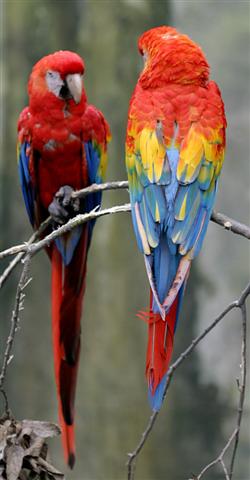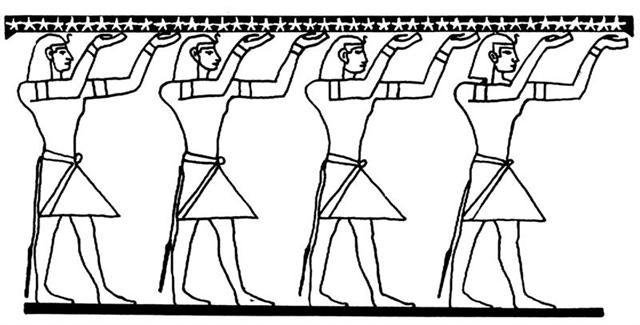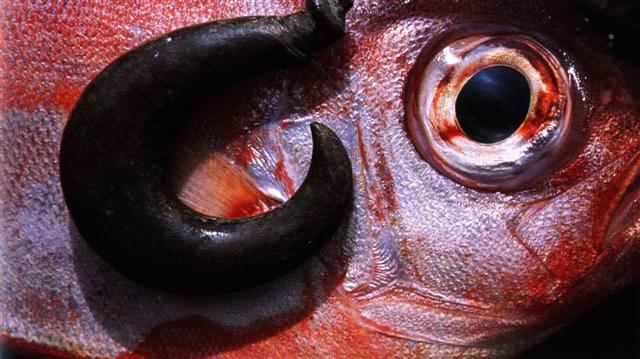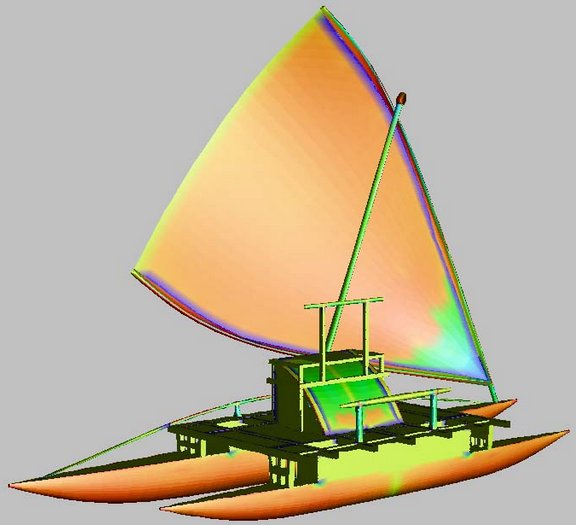Evidently Gregory XIII had placed the Woman in Chains (Manus Catenata, ι Andromeda) 354 days after 0h and the Virgin star (Adara, ε Canis Majoris) at his last day of ºJune, viz. at heliacal Sirius, and possibly this pattern had influenced the creator of the C text:
The Pope had changed the Julian date for spring equinox to ºMarch 21, i.e. he had put the equinox 4 days earlier than before. However, at my assumed time for rongorongo precession would have moved the relevant stars 4 days ahead in the year and his change was therefore precisely annullated, with Alcyone once again in her proper place in the calendar and the 6 stars (Tau-ono) marking 6 times 10 weeks counted from 0h:
Rain (te ua) was drawn reversed (finished) and with emphasis in Cb12-2, i.e. at the neck of the great Eagle and at the last of 183 (July 2) + 200 = 383 days. But then the sky dome had to be pushed up again, the great Fire in the sky had to start up again - in the on average coldest day of the year north of the equator. ... A man had a daughter who possessed a wonderful bow and arrow, with which she was able to bring down everything she wanted. But she was lazy and was constantly sleeping. At this her father was angry and said: 'Do not be always sleeping, but take thy bow and shoot at the navel of the ocean, so that we may get fire.' The navel of the ocean was a vast whirlpool in which sticks for making fire by friction were drifting about. At that time men were still without fire. Now the maiden seized her bow, shot into the navel of the ocean, and the material for fire-rubbing sprang ashore ... Probably the 'thumb' mata drawn at Adara and τ Aquilae meant the Old Sun was present during these 200 days of rain. This can then be interpreted as a rainbow season, a season of beautiful colours.
... Men and birds joined forces to destroy the huge watersnake, which dragged all living creatures down to his lair. But the attackers took fright and cried off, one after the other, offering as their excuse that they could only fight on dry land. Finally, the duckler (K.G.: a diver) was brave enough to dive into the water; he inflicted a fatal wound on the monster which was at the bottom, coiled round the roots of an enormous tree. Uttering terrible cries, the men succeeded in bringing the snake out of the water, where they killed it and removed its skin. The duckler claimed the skin as the price of its victory. The Indian chiefs said ironically, 'By all means! Just take it away!' 'With pleasure', replied the duckler as it signalled to the other birds. Together they swooped down and, each one taking a piece of the skin in its beak, flew off with it. The Indians were annoyed and angry and, from then on, became the enemies of birds. The birds retired to a quiet spot in order to share the skin. They agreed that each one should keep the part that was in its own beak. The skin was made up of marvelous colors - red, yellow, green, black, and white - and had markings such as no one had ever seen before. As soon as each bird was provided with the part to which it was entitled, the miracle happened: until that time all birds had had dingy plumage, but now suddenly they became white, yellow, and blue ... The parrots were covered in green and red, and the macaws with red, purple, and gilded feathers, such as had never before been seen. The duckler, to which all the credit was due, was left with the head, which was black. But it said it was good enough for an old bird ...
... The Katawihi distinguish two rainbows: Mawali in the west, and Tini in the east. Tini and Mawali were twin brothers who brought about the flood that inundated the whole world and killed all living people, except two young girls whom they saved to be their companions. It is not advisable to look either of them straight in the eye: to look at Mawali is to become flabby, lazy, and unlucky at hunting and fishing; to look at Tini makes a man so clumsy that he cannot go any distance without stumbling and lacerating his feet against all obstacles in his path, or pick up a sharp instrument without cutting himself ... The Mura also believed that there were two rainbows, an 'upper' and a 'lower' ... Similarly, the Tucuna differentiated between the eastern and the western rainbows and believed them both to be subaquatic demons, the masters of fish and potter's clay respectively ... The great Fish (ika) was rising again from the deeps, as we can see from its sky supporting sign beneath its open mouth.
It would take 118 = 4 * 29½ nights for the Sun Fish to once again reach heliacal Alcyone. And the last of these nights was number 420 counted from 0h in the previous year. At the time of the Gate of the Goat the Six Stars (Stones) had been at the Sun 75 nights earlier, viz. in ●MARCH 1 (60).
Although Metoro said te ika at the rising fish, its open mouth and added fins suggest the vaha mea (red opening) type of glyph:
And then we obviously have to consider the sky raising sign which turns the fish into a very special kind, the kahi.
... I'a is the general name for fishes,' Pratt notes in his Samoan dictionary, 'except the bonito and shellfish (mollusca and crustacea).' We may forgive the inaccuracy of the biology in our gratitude for the former note. The bonito is not a fish, the bonito is a gentleman, and not for worlds would Samoa offend against his state. The Samoan in his 'upu fa'aaloalo has his own Basakrama, the language of courtesy to be used to them of high degree, to chiefs and bonitos. One does not say that he goes to the towns which are favorably situated for the bonito fishery; he says rather that (funa'i) he goes into seclusion, he withdraws himself. He finds that the fleet which is to chase the bonito has an honourable name for this use, that the chief fisher has a name that he never uses ashore. He will not in so many words say that he is going to fish for bonito, he says that he is going out paddling in the courtesy language (alo); he even avoids all chance of offending this gentleman of his seas by saying, instead of the blunt vulgarity of the word fishing, rather that he is headed in some other direction (fa'asanga'ese). He does not paddle with the common word but with that (pale) which he uses in compliment to his chief's canoe. He will not so much as speak the word which means canoe; he calls it by another word (tafānga), which may mean the turning away to one side. In this unmentioned canoe he may not carry water by its common name, he must call it (mālū) the cool stuff. He will not mention his eyes in the canoe; he calls his visor (taulauifi) the shield for his chestnut leaves. Even the word for large becomes something else (sumalie) in this great game. The hook must be tied with ritual care; it is called (pa) out of the common name for hook; no bonito will take a hook which has not been properly tied; the fastening is veiled under the name (fanua) for the land. There are many rules to observe; their disregard is called (sopoliu) the stepping over the bilges, from the most unfortunate thing that the fisher can do. He may hail the bonito by his name (atu), or he may call him affectionately or coaxingly (pa'umasunu) old singed-skin. If he has the fortune to hook his bonito he must raise the shout of triumph, Tu! Tu! Tu e!, not his whole name but one of its syllables; he triumphs as over a foe honorably slain in combat, but he avoids hurting the feelings of the other gentlemen of the sea. The first bonito caught in a new canoe he calls (ola) life; the first bonito caught in any season bears a special name (ngatongiā), of uncertain signification, and he presents it to his chief. His catch he reckons by a special notation; to his numerals he adds the word (tino) body; he counts them as one-body, two-body, three-body. Parts of the gentleman have specific names of their own; his fins (asa) and his entrails (fe'afe'a) are called in terms nowhere else employed; the tidbit of the belly part, which the fisher must give to his chief, is called (ma'alo) by the honorific title of the chief's abdomen. And if the rites were not duly observed, if the hook was not rightly tied, if the fisher was so incautious as to mention his eyes, if one of a hundred faults was committed and the fishing was in vain, then the fisher acknowledged his ill success abjectly by saying that (maloā) he was conquered. Such is the language Samoans use to the gentleman of the seas, and he is not i'a ...
Perhaps it was significant (intended to convey meaning) that the first Greek lettered star rising after τ Aquilae was η Sagittae, because Alcyone had been assigned the same letter.
String games should not be played too early in the year, when the Sun was feeble. But when the Sun had reached the Pleiades the weather would become nice and good for sailing and fishing. ... another Alcyone, daughter of Pleione, 'Queen of Sailing', by the oak-hero Atlas, was the mystical leader of the seven Pleiads. The heliacal rising of the Pleiads in May marked the beginning of the navigational year; their setting marked its end when (as Pliny notices in a passage about the halcyon) a remarkably cold North wind blows ...
|
||||||||||||||||||||||||||||||||||||||||||||||||||||||||||||||||||||||||||||||||||||||||||||||||||||||||||||||||||||










